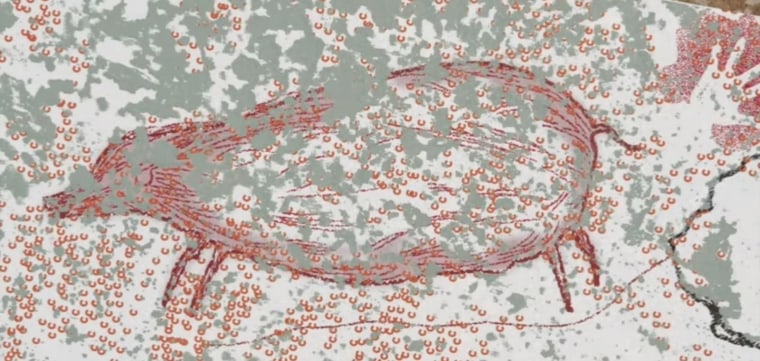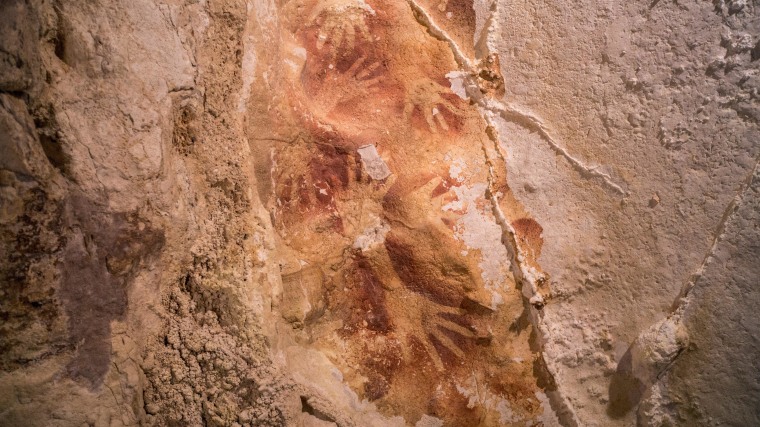A delicate dating method has determined that cave paintings on the Indonesian island of Sulawesi are almost certainly more than 40,000 years old — and that means we'll have to change our perspective on the start of artistry.
The findings, published in this week's issue of the journal Nature, suggest that at the same time European cave artists were making hand stencils and depicting the animals they hunted, ancient humans spread across Asia's archipelagos were doing the same thing thousands of miles away.
"Cave painting and related forms of artistic expression were most likely part of the cultural traditions of the first modern humans to spread out of Africa and into Asia and Australia, long before they reached Europe," Adam Brunn, one of the study's co-authors at Griffith University in Australia, said in a news release.
The international research project was led by Maxime Aubert, a colleague of Brunn's at Griffith.
The Sulawesi paintings were discovered inside limestone karst caves in the island's Maros and Pangkep regions, and have been documented over the course of decades. They include stencils that were created by blowing or spraying reddish pigment around hands that were pressed against the rock surface — as well as sketches of animals, such as the fruit-eating pigs known as babirusas or "pig-deers."
The key question is, how old are those paintings? To answer that question, the research team used tools tipped with diamond saw blades to scrape off millimeter-thick slivers of thin mineral deposits that covered the paintings. The deposits, known as "cave popcorn," were subjected to uranium-thorium radioisotope dating techniques. Because the popcorn built up over the paintings, the results could provide a minimum age for the artwork.
Aubert and his colleagues found that one of the 12 hand stencils they sampled was at least 39,900 years old, and that the pig-deer drawing was made at least 35,400 years ago. That would make the stencil the oldest of its type known in the world, and rank the pig-deer among the world's oldest representational drawings.

Comparable dating techniques have come up with an age of 37,000 years for a hand stencil in Spain's El Castillo cave, and 40,800 years for a red disk in the same cave. Radiocarbon dating suggests that a rhinoceros painting in France's Chauvet cave was created between 32,000 and 39,000 years ago, and traces of red paint found in Italy's Fumane cave suggest that paintings were created there between 36,000 and 41,000 years ago.
"Europeans can't exclusively claim to be the first to develop an abstract mind anymore. They need to share this, at least, with the early inhabitants of Indonesia," study co-author Antonio Dosseto, director of the Wollongong Isotope Geochronology Laboratory at the University of Wollongong in Australia, said in a news release.
Other evidence from Asia suggests that the culture of cave painting could go back significantly further. In a Nature commentary, Leiden University archaeologist Wil Roebroeks notes that worn ochre crayons have been recovered from 50,000-year-old deposits in northern Australia's Arnhem Land.
Roebroeks, who was not a part of Aubert's team, said the latest findings were "spectacular" — but noted that the paintings themselves were facing 21st-century threats.
"Aubert and colleagues' study underlines the great cultural-historical importance of the Maros area, which is under threat from large-scale limestone mining," Roebroeks wrote.
In addition to Aubert, Brumm and Dosseto, the authors of "Pleistocene Cave Art From Sulawesi, Indonesia" include Muhammad Ramli, Budianto Hakim, E. Wahyu Saptomo, Thomas Sutikna, Gert van den Bergh. Les Kinsley and the late Michael Morwood.
